Comprehensive Report: Pre and Post Operative ORIF Management
VerifiedAdded on 2020/04/01
|10
|2412
|147
Report
AI Summary
This report provides a comprehensive overview of the pre and post-operative management of Open Reduction Internal Fixation (ORIF) surgery. It begins with an introduction to ORIF, explaining its purpose in repairing bone fractures and the associated risks. The report then delves into pre-operative management, emphasizing patient education, informed consent, and essential tests like cardiac assessments and radiographic imaging. It highlights the importance of perioperative antibiotics and anesthesia, along with patient comfort and anxiety management. The post-operative section focuses on pain management, infection control, and techniques to prevent bone misalignment, including early weight-bearing and bone stimulation. It also addresses mobility restrictions and the role of diet in promoting bone healing. The report concludes by emphasizing the need for a tailored care plan and the effectiveness of proper pre and post-operative management in achieving optimal outcomes for patients undergoing ORIF surgery. This report is a valuable resource for understanding the complexities of ORIF procedures, and is available for students on Desklib.

Running head: PRE AND POST OPERATIVE MANAGEMENT OF ORIF
Pre and post operative management of ORIF
Name of the student:
Name of the university:
Author note:
Pre and post operative management of ORIF
Name of the student:
Name of the university:
Author note:
Paraphrase This Document
Need a fresh take? Get an instant paraphrase of this document with our AI Paraphraser
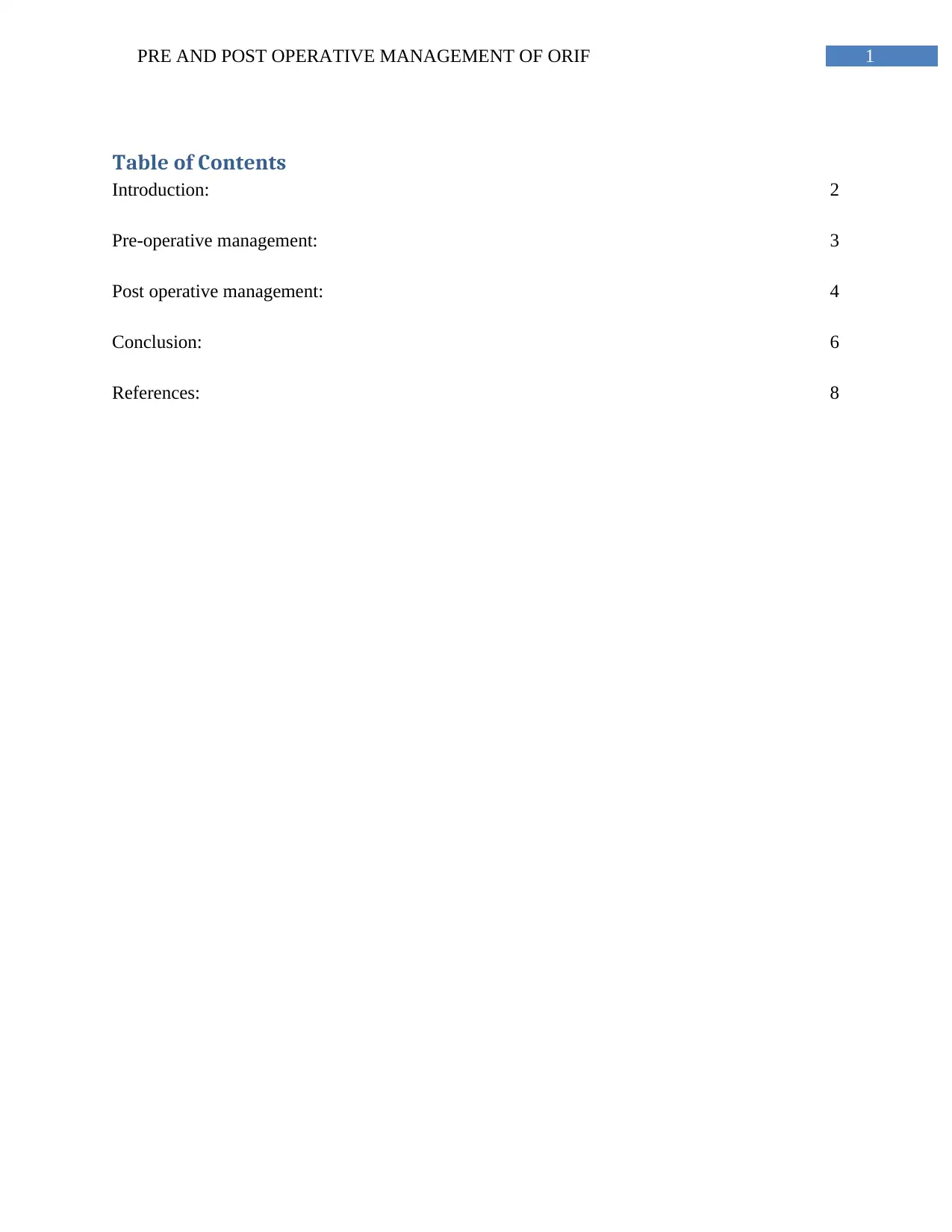
1PRE AND POST OPERATIVE MANAGEMENT OF ORIF
Table of Contents
Introduction: 2
Pre-operative management: 3
Post operative management: 4
Conclusion: 6
References: 8
Table of Contents
Introduction: 2
Pre-operative management: 3
Post operative management: 4
Conclusion: 6
References: 8
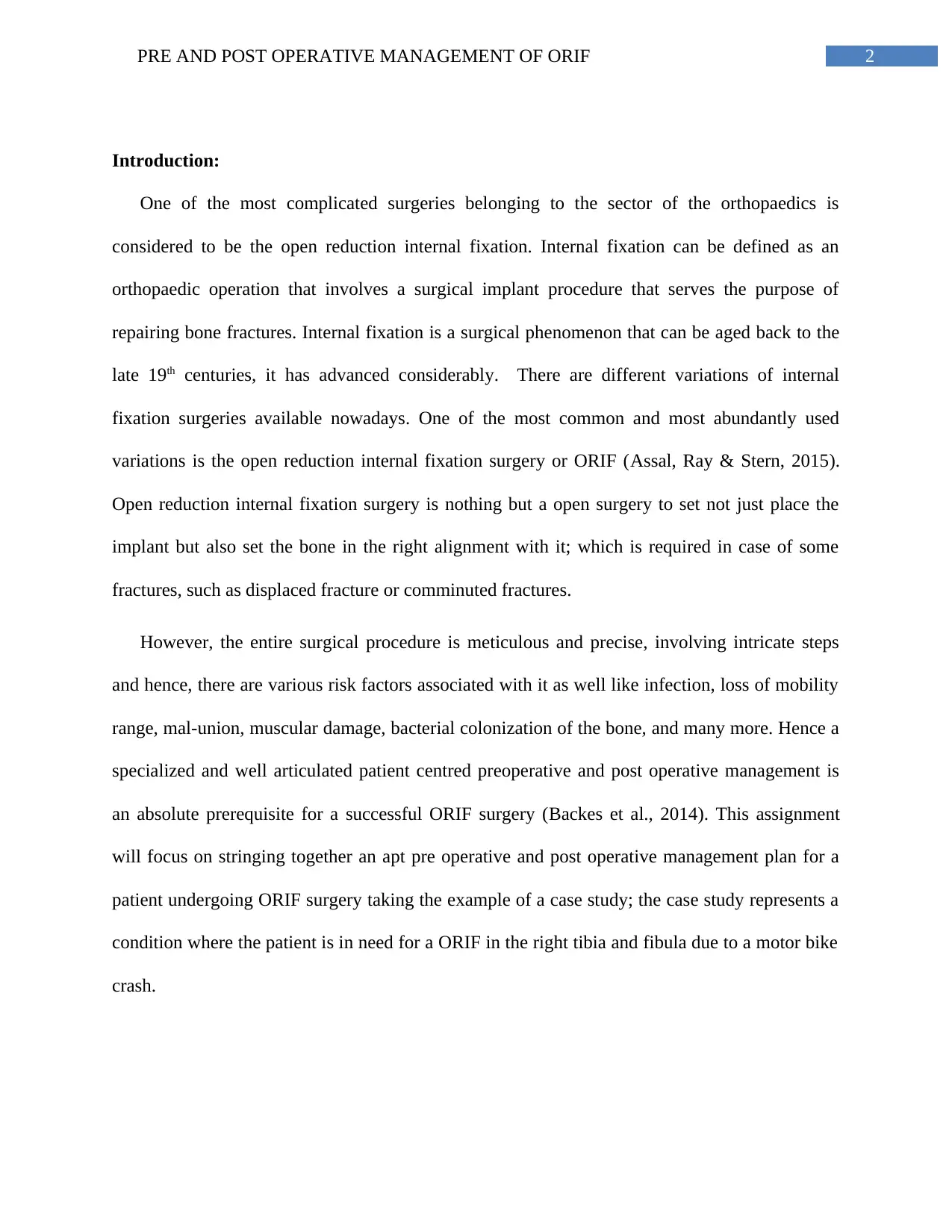
2PRE AND POST OPERATIVE MANAGEMENT OF ORIF
Introduction:
One of the most complicated surgeries belonging to the sector of the orthopaedics is
considered to be the open reduction internal fixation. Internal fixation can be defined as an
orthopaedic operation that involves a surgical implant procedure that serves the purpose of
repairing bone fractures. Internal fixation is a surgical phenomenon that can be aged back to the
late 19th centuries, it has advanced considerably. There are different variations of internal
fixation surgeries available nowadays. One of the most common and most abundantly used
variations is the open reduction internal fixation surgery or ORIF (Assal, Ray & Stern, 2015).
Open reduction internal fixation surgery is nothing but a open surgery to set not just place the
implant but also set the bone in the right alignment with it; which is required in case of some
fractures, such as displaced fracture or comminuted fractures.
However, the entire surgical procedure is meticulous and precise, involving intricate steps
and hence, there are various risk factors associated with it as well like infection, loss of mobility
range, mal-union, muscular damage, bacterial colonization of the bone, and many more. Hence a
specialized and well articulated patient centred preoperative and post operative management is
an absolute prerequisite for a successful ORIF surgery (Backes et al., 2014). This assignment
will focus on stringing together an apt pre operative and post operative management plan for a
patient undergoing ORIF surgery taking the example of a case study; the case study represents a
condition where the patient is in need for a ORIF in the right tibia and fibula due to a motor bike
crash.
Introduction:
One of the most complicated surgeries belonging to the sector of the orthopaedics is
considered to be the open reduction internal fixation. Internal fixation can be defined as an
orthopaedic operation that involves a surgical implant procedure that serves the purpose of
repairing bone fractures. Internal fixation is a surgical phenomenon that can be aged back to the
late 19th centuries, it has advanced considerably. There are different variations of internal
fixation surgeries available nowadays. One of the most common and most abundantly used
variations is the open reduction internal fixation surgery or ORIF (Assal, Ray & Stern, 2015).
Open reduction internal fixation surgery is nothing but a open surgery to set not just place the
implant but also set the bone in the right alignment with it; which is required in case of some
fractures, such as displaced fracture or comminuted fractures.
However, the entire surgical procedure is meticulous and precise, involving intricate steps
and hence, there are various risk factors associated with it as well like infection, loss of mobility
range, mal-union, muscular damage, bacterial colonization of the bone, and many more. Hence a
specialized and well articulated patient centred preoperative and post operative management is
an absolute prerequisite for a successful ORIF surgery (Backes et al., 2014). This assignment
will focus on stringing together an apt pre operative and post operative management plan for a
patient undergoing ORIF surgery taking the example of a case study; the case study represents a
condition where the patient is in need for a ORIF in the right tibia and fibula due to a motor bike
crash.
⊘ This is a preview!⊘
Do you want full access?
Subscribe today to unlock all pages.

Trusted by 1+ million students worldwide
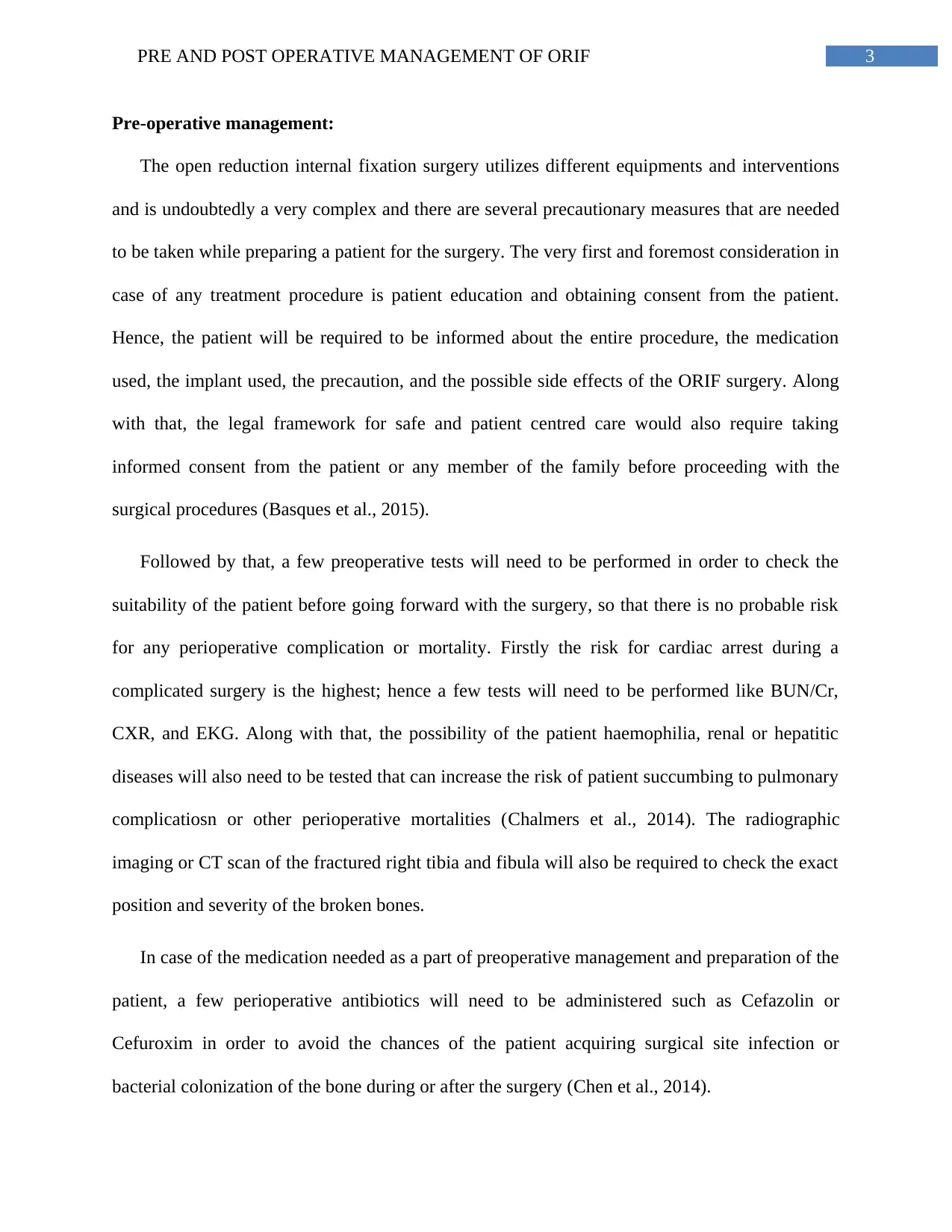
3PRE AND POST OPERATIVE MANAGEMENT OF ORIF
Pre-operative management:
The open reduction internal fixation surgery utilizes different equipments and interventions
and is undoubtedly a very complex and there are several precautionary measures that are needed
to be taken while preparing a patient for the surgery. The very first and foremost consideration in
case of any treatment procedure is patient education and obtaining consent from the patient.
Hence, the patient will be required to be informed about the entire procedure, the medication
used, the implant used, the precaution, and the possible side effects of the ORIF surgery. Along
with that, the legal framework for safe and patient centred care would also require taking
informed consent from the patient or any member of the family before proceeding with the
surgical procedures (Basques et al., 2015).
Followed by that, a few preoperative tests will need to be performed in order to check the
suitability of the patient before going forward with the surgery, so that there is no probable risk
for any perioperative complication or mortality. Firstly the risk for cardiac arrest during a
complicated surgery is the highest; hence a few tests will need to be performed like BUN/Cr,
CXR, and EKG. Along with that, the possibility of the patient haemophilia, renal or hepatitic
diseases will also need to be tested that can increase the risk of patient succumbing to pulmonary
complicatiosn or other perioperative mortalities (Chalmers et al., 2014). The radiographic
imaging or CT scan of the fractured right tibia and fibula will also be required to check the exact
position and severity of the broken bones.
In case of the medication needed as a part of preoperative management and preparation of the
patient, a few perioperative antibiotics will need to be administered such as Cefazolin or
Cefuroxim in order to avoid the chances of the patient acquiring surgical site infection or
bacterial colonization of the bone during or after the surgery (Chen et al., 2014).
Pre-operative management:
The open reduction internal fixation surgery utilizes different equipments and interventions
and is undoubtedly a very complex and there are several precautionary measures that are needed
to be taken while preparing a patient for the surgery. The very first and foremost consideration in
case of any treatment procedure is patient education and obtaining consent from the patient.
Hence, the patient will be required to be informed about the entire procedure, the medication
used, the implant used, the precaution, and the possible side effects of the ORIF surgery. Along
with that, the legal framework for safe and patient centred care would also require taking
informed consent from the patient or any member of the family before proceeding with the
surgical procedures (Basques et al., 2015).
Followed by that, a few preoperative tests will need to be performed in order to check the
suitability of the patient before going forward with the surgery, so that there is no probable risk
for any perioperative complication or mortality. Firstly the risk for cardiac arrest during a
complicated surgery is the highest; hence a few tests will need to be performed like BUN/Cr,
CXR, and EKG. Along with that, the possibility of the patient haemophilia, renal or hepatitic
diseases will also need to be tested that can increase the risk of patient succumbing to pulmonary
complicatiosn or other perioperative mortalities (Chalmers et al., 2014). The radiographic
imaging or CT scan of the fractured right tibia and fibula will also be required to check the exact
position and severity of the broken bones.
In case of the medication needed as a part of preoperative management and preparation of the
patient, a few perioperative antibiotics will need to be administered such as Cefazolin or
Cefuroxim in order to avoid the chances of the patient acquiring surgical site infection or
bacterial colonization of the bone during or after the surgery (Chen et al., 2014).
Paraphrase This Document
Need a fresh take? Get an instant paraphrase of this document with our AI Paraphraser
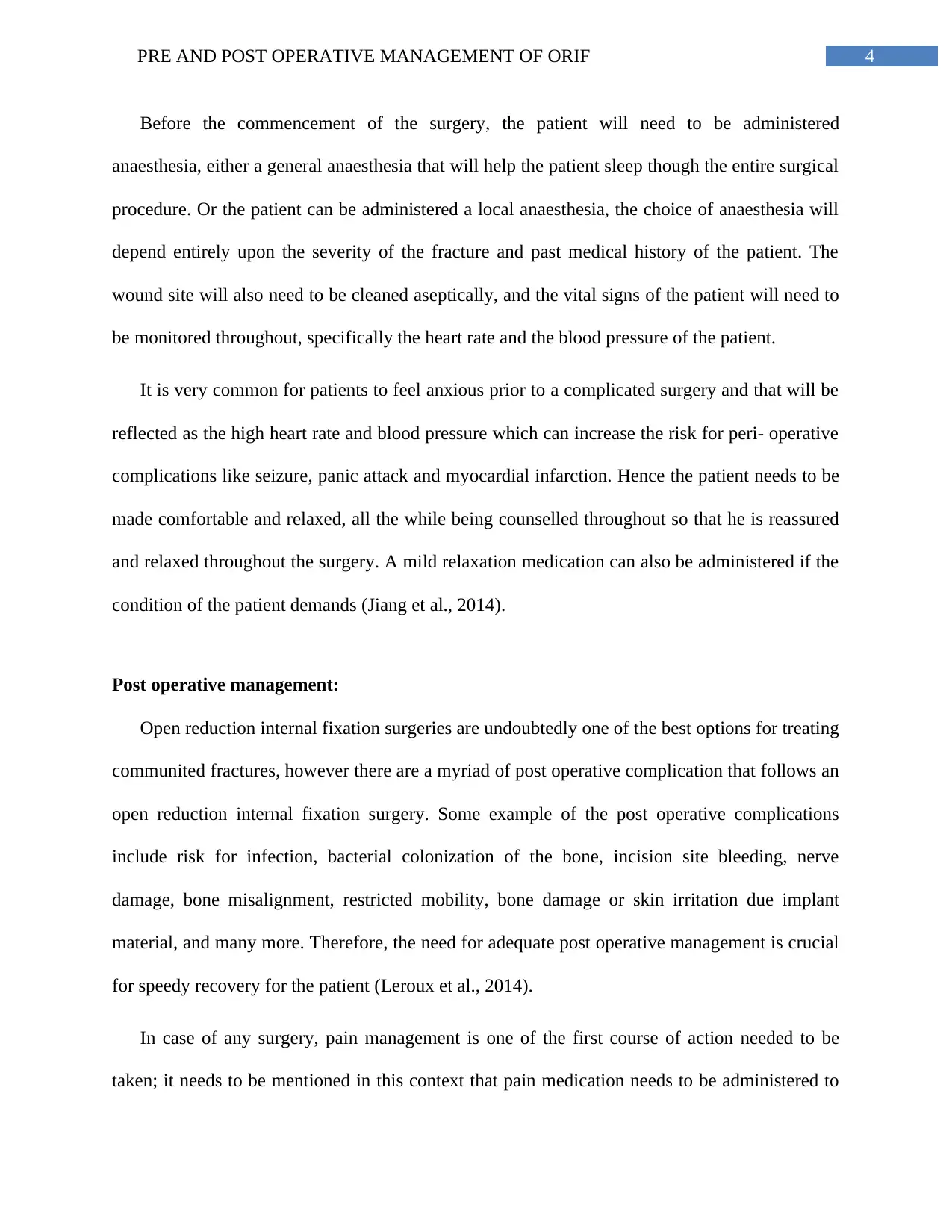
4PRE AND POST OPERATIVE MANAGEMENT OF ORIF
Before the commencement of the surgery, the patient will need to be administered
anaesthesia, either a general anaesthesia that will help the patient sleep though the entire surgical
procedure. Or the patient can be administered a local anaesthesia, the choice of anaesthesia will
depend entirely upon the severity of the fracture and past medical history of the patient. The
wound site will also need to be cleaned aseptically, and the vital signs of the patient will need to
be monitored throughout, specifically the heart rate and the blood pressure of the patient.
It is very common for patients to feel anxious prior to a complicated surgery and that will be
reflected as the high heart rate and blood pressure which can increase the risk for peri- operative
complications like seizure, panic attack and myocardial infarction. Hence the patient needs to be
made comfortable and relaxed, all the while being counselled throughout so that he is reassured
and relaxed throughout the surgery. A mild relaxation medication can also be administered if the
condition of the patient demands (Jiang et al., 2014).
Post operative management:
Open reduction internal fixation surgeries are undoubtedly one of the best options for treating
communited fractures, however there are a myriad of post operative complication that follows an
open reduction internal fixation surgery. Some example of the post operative complications
include risk for infection, bacterial colonization of the bone, incision site bleeding, nerve
damage, bone misalignment, restricted mobility, bone damage or skin irritation due implant
material, and many more. Therefore, the need for adequate post operative management is crucial
for speedy recovery for the patient (Leroux et al., 2014).
In case of any surgery, pain management is one of the first course of action needed to be
taken; it needs to be mentioned in this context that pain medication needs to be administered to
Before the commencement of the surgery, the patient will need to be administered
anaesthesia, either a general anaesthesia that will help the patient sleep though the entire surgical
procedure. Or the patient can be administered a local anaesthesia, the choice of anaesthesia will
depend entirely upon the severity of the fracture and past medical history of the patient. The
wound site will also need to be cleaned aseptically, and the vital signs of the patient will need to
be monitored throughout, specifically the heart rate and the blood pressure of the patient.
It is very common for patients to feel anxious prior to a complicated surgery and that will be
reflected as the high heart rate and blood pressure which can increase the risk for peri- operative
complications like seizure, panic attack and myocardial infarction. Hence the patient needs to be
made comfortable and relaxed, all the while being counselled throughout so that he is reassured
and relaxed throughout the surgery. A mild relaxation medication can also be administered if the
condition of the patient demands (Jiang et al., 2014).
Post operative management:
Open reduction internal fixation surgeries are undoubtedly one of the best options for treating
communited fractures, however there are a myriad of post operative complication that follows an
open reduction internal fixation surgery. Some example of the post operative complications
include risk for infection, bacterial colonization of the bone, incision site bleeding, nerve
damage, bone misalignment, restricted mobility, bone damage or skin irritation due implant
material, and many more. Therefore, the need for adequate post operative management is crucial
for speedy recovery for the patient (Leroux et al., 2014).
In case of any surgery, pain management is one of the first course of action needed to be
taken; it needs to be mentioned in this context that pain medication needs to be administered to
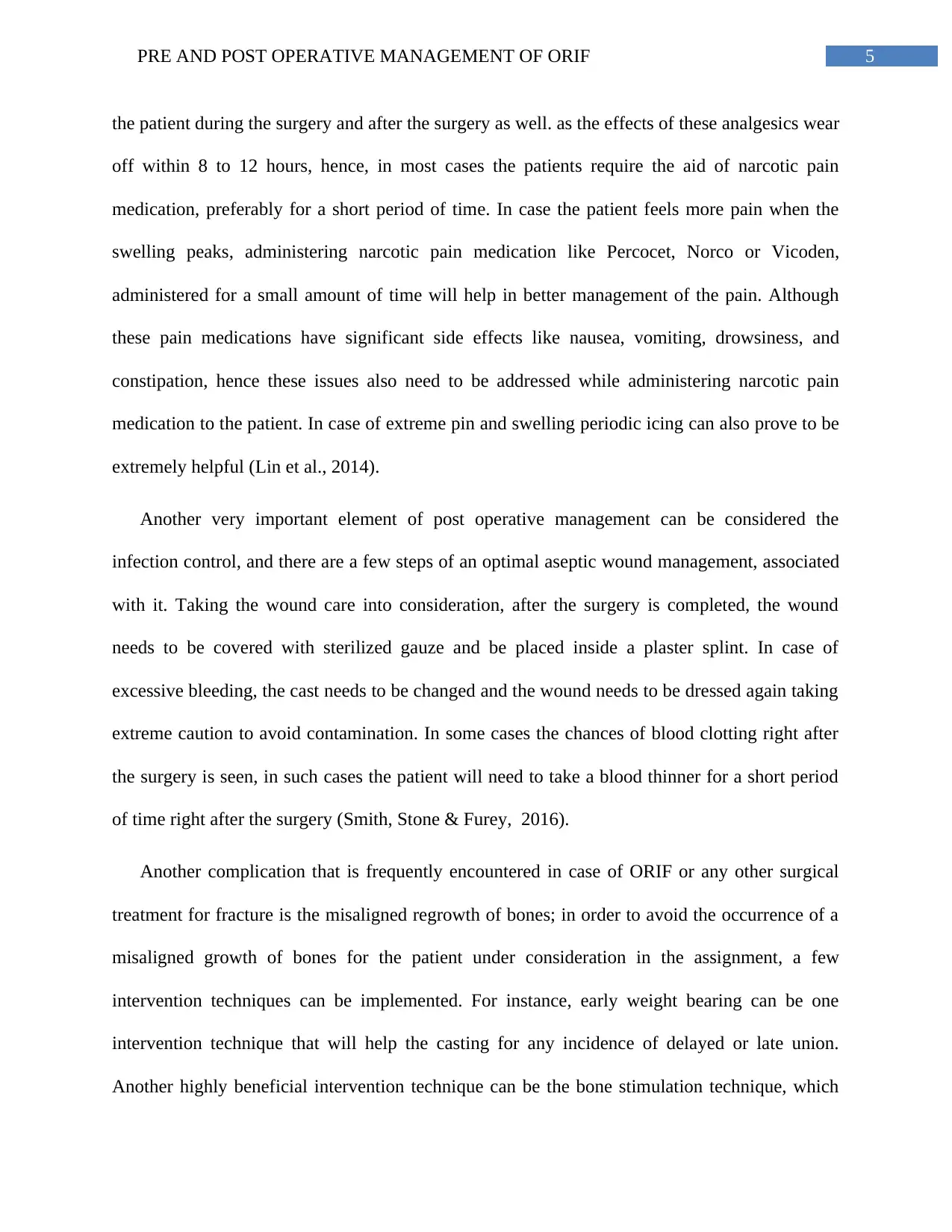
5PRE AND POST OPERATIVE MANAGEMENT OF ORIF
the patient during the surgery and after the surgery as well. as the effects of these analgesics wear
off within 8 to 12 hours, hence, in most cases the patients require the aid of narcotic pain
medication, preferably for a short period of time. In case the patient feels more pain when the
swelling peaks, administering narcotic pain medication like Percocet, Norco or Vicoden,
administered for a small amount of time will help in better management of the pain. Although
these pain medications have significant side effects like nausea, vomiting, drowsiness, and
constipation, hence these issues also need to be addressed while administering narcotic pain
medication to the patient. In case of extreme pin and swelling periodic icing can also prove to be
extremely helpful (Lin et al., 2014).
Another very important element of post operative management can be considered the
infection control, and there are a few steps of an optimal aseptic wound management, associated
with it. Taking the wound care into consideration, after the surgery is completed, the wound
needs to be covered with sterilized gauze and be placed inside a plaster splint. In case of
excessive bleeding, the cast needs to be changed and the wound needs to be dressed again taking
extreme caution to avoid contamination. In some cases the chances of blood clotting right after
the surgery is seen, in such cases the patient will need to take a blood thinner for a short period
of time right after the surgery (Smith, Stone & Furey, 2016).
Another complication that is frequently encountered in case of ORIF or any other surgical
treatment for fracture is the misaligned regrowth of bones; in order to avoid the occurrence of a
misaligned growth of bones for the patient under consideration in the assignment, a few
intervention techniques can be implemented. For instance, early weight bearing can be one
intervention technique that will help the casting for any incidence of delayed or late union.
Another highly beneficial intervention technique can be the bone stimulation technique, which
the patient during the surgery and after the surgery as well. as the effects of these analgesics wear
off within 8 to 12 hours, hence, in most cases the patients require the aid of narcotic pain
medication, preferably for a short period of time. In case the patient feels more pain when the
swelling peaks, administering narcotic pain medication like Percocet, Norco or Vicoden,
administered for a small amount of time will help in better management of the pain. Although
these pain medications have significant side effects like nausea, vomiting, drowsiness, and
constipation, hence these issues also need to be addressed while administering narcotic pain
medication to the patient. In case of extreme pin and swelling periodic icing can also prove to be
extremely helpful (Lin et al., 2014).
Another very important element of post operative management can be considered the
infection control, and there are a few steps of an optimal aseptic wound management, associated
with it. Taking the wound care into consideration, after the surgery is completed, the wound
needs to be covered with sterilized gauze and be placed inside a plaster splint. In case of
excessive bleeding, the cast needs to be changed and the wound needs to be dressed again taking
extreme caution to avoid contamination. In some cases the chances of blood clotting right after
the surgery is seen, in such cases the patient will need to take a blood thinner for a short period
of time right after the surgery (Smith, Stone & Furey, 2016).
Another complication that is frequently encountered in case of ORIF or any other surgical
treatment for fracture is the misaligned regrowth of bones; in order to avoid the occurrence of a
misaligned growth of bones for the patient under consideration in the assignment, a few
intervention techniques can be implemented. For instance, early weight bearing can be one
intervention technique that will help the casting for any incidence of delayed or late union.
Another highly beneficial intervention technique can be the bone stimulation technique, which
⊘ This is a preview!⊘
Do you want full access?
Subscribe today to unlock all pages.

Trusted by 1+ million students worldwide
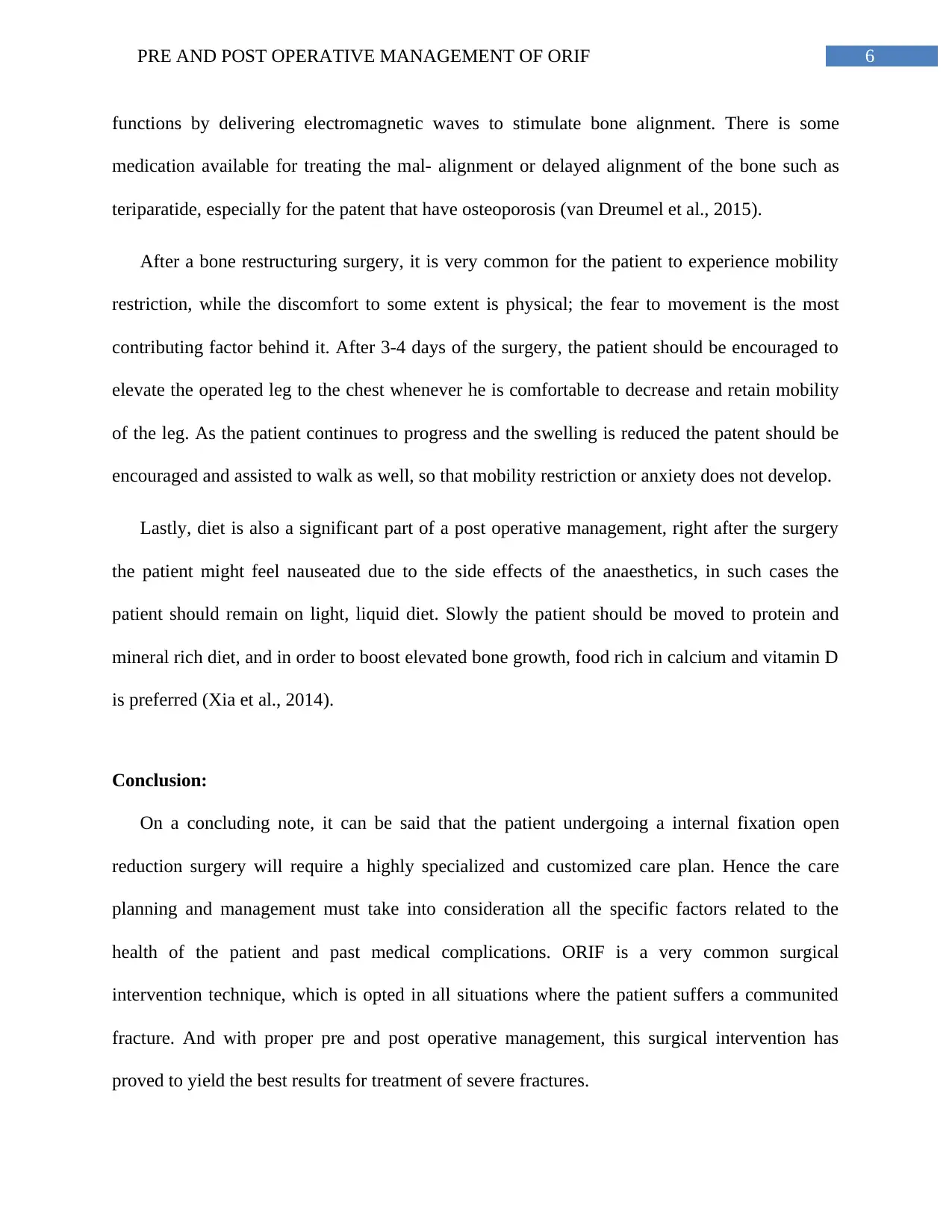
6PRE AND POST OPERATIVE MANAGEMENT OF ORIF
functions by delivering electromagnetic waves to stimulate bone alignment. There is some
medication available for treating the mal- alignment or delayed alignment of the bone such as
teriparatide, especially for the patent that have osteoporosis (van Dreumel et al., 2015).
After a bone restructuring surgery, it is very common for the patient to experience mobility
restriction, while the discomfort to some extent is physical; the fear to movement is the most
contributing factor behind it. After 3-4 days of the surgery, the patient should be encouraged to
elevate the operated leg to the chest whenever he is comfortable to decrease and retain mobility
of the leg. As the patient continues to progress and the swelling is reduced the patent should be
encouraged and assisted to walk as well, so that mobility restriction or anxiety does not develop.
Lastly, diet is also a significant part of a post operative management, right after the surgery
the patient might feel nauseated due to the side effects of the anaesthetics, in such cases the
patient should remain on light, liquid diet. Slowly the patient should be moved to protein and
mineral rich diet, and in order to boost elevated bone growth, food rich in calcium and vitamin D
is preferred (Xia et al., 2014).
Conclusion:
On a concluding note, it can be said that the patient undergoing a internal fixation open
reduction surgery will require a highly specialized and customized care plan. Hence the care
planning and management must take into consideration all the specific factors related to the
health of the patient and past medical complications. ORIF is a very common surgical
intervention technique, which is opted in all situations where the patient suffers a communited
fracture. And with proper pre and post operative management, this surgical intervention has
proved to yield the best results for treatment of severe fractures.
functions by delivering electromagnetic waves to stimulate bone alignment. There is some
medication available for treating the mal- alignment or delayed alignment of the bone such as
teriparatide, especially for the patent that have osteoporosis (van Dreumel et al., 2015).
After a bone restructuring surgery, it is very common for the patient to experience mobility
restriction, while the discomfort to some extent is physical; the fear to movement is the most
contributing factor behind it. After 3-4 days of the surgery, the patient should be encouraged to
elevate the operated leg to the chest whenever he is comfortable to decrease and retain mobility
of the leg. As the patient continues to progress and the swelling is reduced the patent should be
encouraged and assisted to walk as well, so that mobility restriction or anxiety does not develop.
Lastly, diet is also a significant part of a post operative management, right after the surgery
the patient might feel nauseated due to the side effects of the anaesthetics, in such cases the
patient should remain on light, liquid diet. Slowly the patient should be moved to protein and
mineral rich diet, and in order to boost elevated bone growth, food rich in calcium and vitamin D
is preferred (Xia et al., 2014).
Conclusion:
On a concluding note, it can be said that the patient undergoing a internal fixation open
reduction surgery will require a highly specialized and customized care plan. Hence the care
planning and management must take into consideration all the specific factors related to the
health of the patient and past medical complications. ORIF is a very common surgical
intervention technique, which is opted in all situations where the patient suffers a communited
fracture. And with proper pre and post operative management, this surgical intervention has
proved to yield the best results for treatment of severe fractures.
Paraphrase This Document
Need a fresh take? Get an instant paraphrase of this document with our AI Paraphraser

7PRE AND POST OPERATIVE MANAGEMENT OF ORIF
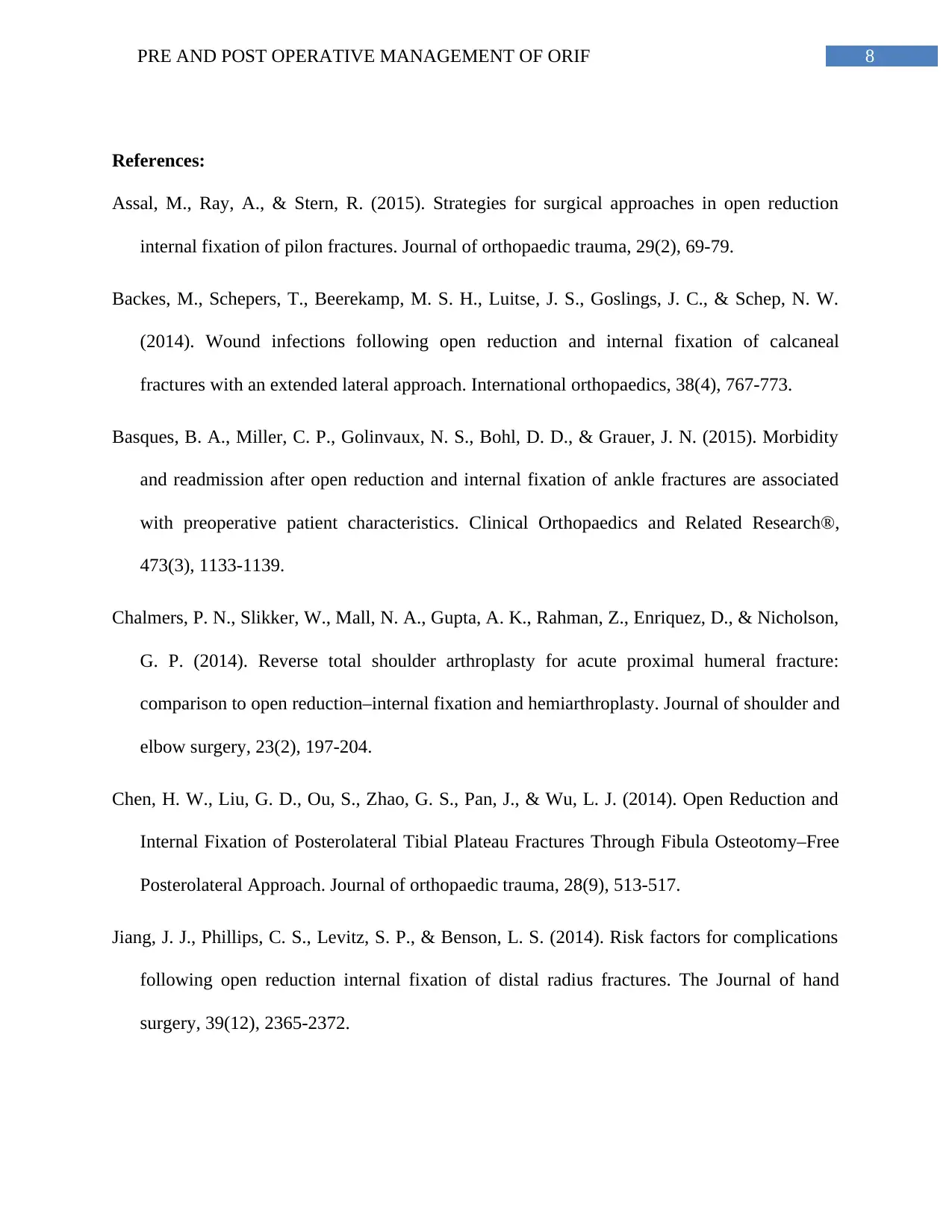
8PRE AND POST OPERATIVE MANAGEMENT OF ORIF
References:
Assal, M., Ray, A., & Stern, R. (2015). Strategies for surgical approaches in open reduction
internal fixation of pilon fractures. Journal of orthopaedic trauma, 29(2), 69-79.
Backes, M., Schepers, T., Beerekamp, M. S. H., Luitse, J. S., Goslings, J. C., & Schep, N. W.
(2014). Wound infections following open reduction and internal fixation of calcaneal
fractures with an extended lateral approach. International orthopaedics, 38(4), 767-773.
Basques, B. A., Miller, C. P., Golinvaux, N. S., Bohl, D. D., & Grauer, J. N. (2015). Morbidity
and readmission after open reduction and internal fixation of ankle fractures are associated
with preoperative patient characteristics. Clinical Orthopaedics and Related Research®,
473(3), 1133-1139.
Chalmers, P. N., Slikker, W., Mall, N. A., Gupta, A. K., Rahman, Z., Enriquez, D., & Nicholson,
G. P. (2014). Reverse total shoulder arthroplasty for acute proximal humeral fracture:
comparison to open reduction–internal fixation and hemiarthroplasty. Journal of shoulder and
elbow surgery, 23(2), 197-204.
Chen, H. W., Liu, G. D., Ou, S., Zhao, G. S., Pan, J., & Wu, L. J. (2014). Open Reduction and
Internal Fixation of Posterolateral Tibial Plateau Fractures Through Fibula Osteotomy–Free
Posterolateral Approach. Journal of orthopaedic trauma, 28(9), 513-517.
Jiang, J. J., Phillips, C. S., Levitz, S. P., & Benson, L. S. (2014). Risk factors for complications
following open reduction internal fixation of distal radius fractures. The Journal of hand
surgery, 39(12), 2365-2372.
References:
Assal, M., Ray, A., & Stern, R. (2015). Strategies for surgical approaches in open reduction
internal fixation of pilon fractures. Journal of orthopaedic trauma, 29(2), 69-79.
Backes, M., Schepers, T., Beerekamp, M. S. H., Luitse, J. S., Goslings, J. C., & Schep, N. W.
(2014). Wound infections following open reduction and internal fixation of calcaneal
fractures with an extended lateral approach. International orthopaedics, 38(4), 767-773.
Basques, B. A., Miller, C. P., Golinvaux, N. S., Bohl, D. D., & Grauer, J. N. (2015). Morbidity
and readmission after open reduction and internal fixation of ankle fractures are associated
with preoperative patient characteristics. Clinical Orthopaedics and Related Research®,
473(3), 1133-1139.
Chalmers, P. N., Slikker, W., Mall, N. A., Gupta, A. K., Rahman, Z., Enriquez, D., & Nicholson,
G. P. (2014). Reverse total shoulder arthroplasty for acute proximal humeral fracture:
comparison to open reduction–internal fixation and hemiarthroplasty. Journal of shoulder and
elbow surgery, 23(2), 197-204.
Chen, H. W., Liu, G. D., Ou, S., Zhao, G. S., Pan, J., & Wu, L. J. (2014). Open Reduction and
Internal Fixation of Posterolateral Tibial Plateau Fractures Through Fibula Osteotomy–Free
Posterolateral Approach. Journal of orthopaedic trauma, 28(9), 513-517.
Jiang, J. J., Phillips, C. S., Levitz, S. P., & Benson, L. S. (2014). Risk factors for complications
following open reduction internal fixation of distal radius fractures. The Journal of hand
surgery, 39(12), 2365-2372.
⊘ This is a preview!⊘
Do you want full access?
Subscribe today to unlock all pages.

Trusted by 1+ million students worldwide
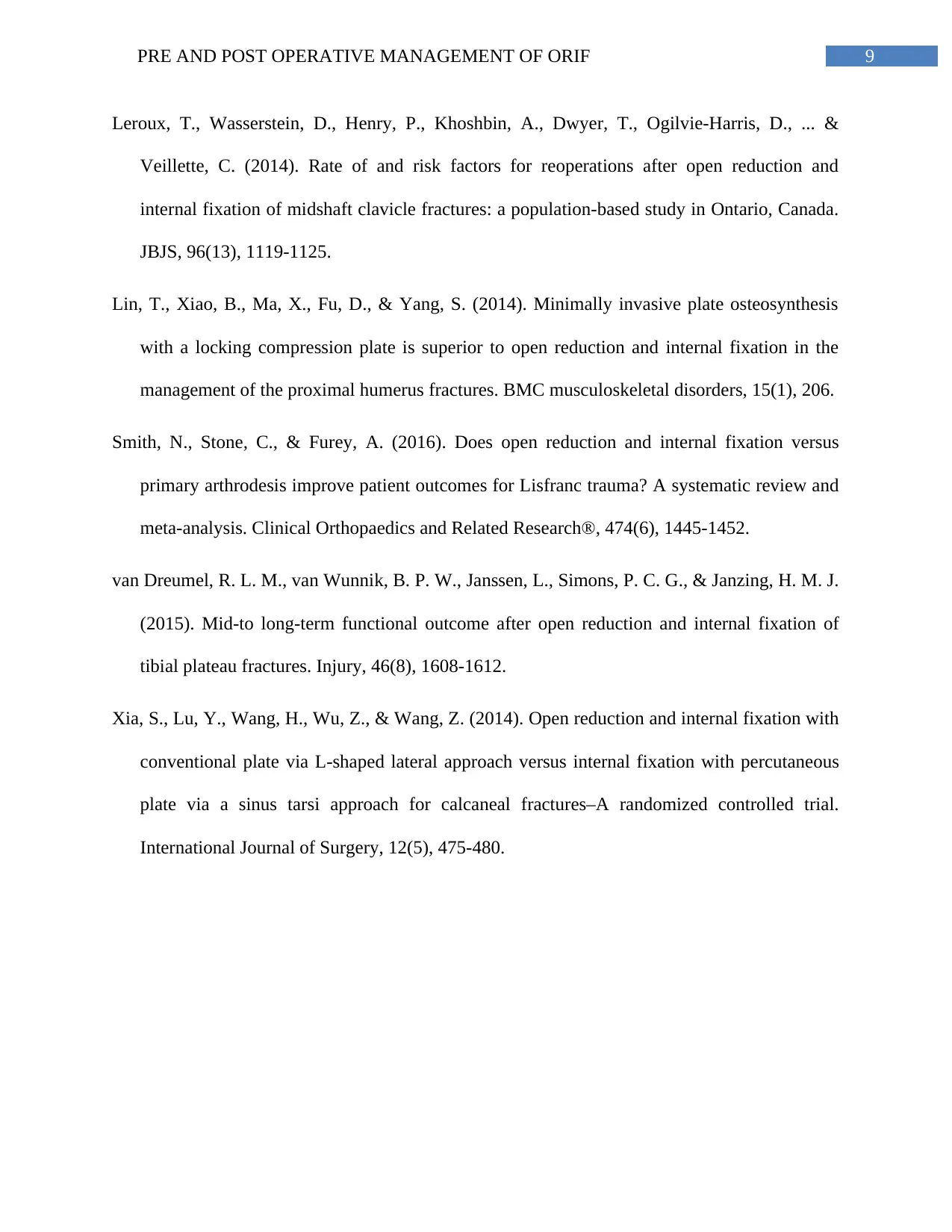
9PRE AND POST OPERATIVE MANAGEMENT OF ORIF
Leroux, T., Wasserstein, D., Henry, P., Khoshbin, A., Dwyer, T., Ogilvie-Harris, D., ... &
Veillette, C. (2014). Rate of and risk factors for reoperations after open reduction and
internal fixation of midshaft clavicle fractures: a population-based study in Ontario, Canada.
JBJS, 96(13), 1119-1125.
Lin, T., Xiao, B., Ma, X., Fu, D., & Yang, S. (2014). Minimally invasive plate osteosynthesis
with a locking compression plate is superior to open reduction and internal fixation in the
management of the proximal humerus fractures. BMC musculoskeletal disorders, 15(1), 206.
Smith, N., Stone, C., & Furey, A. (2016). Does open reduction and internal fixation versus
primary arthrodesis improve patient outcomes for Lisfranc trauma? A systematic review and
meta-analysis. Clinical Orthopaedics and Related Research®, 474(6), 1445-1452.
van Dreumel, R. L. M., van Wunnik, B. P. W., Janssen, L., Simons, P. C. G., & Janzing, H. M. J.
(2015). Mid-to long-term functional outcome after open reduction and internal fixation of
tibial plateau fractures. Injury, 46(8), 1608-1612.
Xia, S., Lu, Y., Wang, H., Wu, Z., & Wang, Z. (2014). Open reduction and internal fixation with
conventional plate via L-shaped lateral approach versus internal fixation with percutaneous
plate via a sinus tarsi approach for calcaneal fractures–A randomized controlled trial.
International Journal of Surgery, 12(5), 475-480.
Leroux, T., Wasserstein, D., Henry, P., Khoshbin, A., Dwyer, T., Ogilvie-Harris, D., ... &
Veillette, C. (2014). Rate of and risk factors for reoperations after open reduction and
internal fixation of midshaft clavicle fractures: a population-based study in Ontario, Canada.
JBJS, 96(13), 1119-1125.
Lin, T., Xiao, B., Ma, X., Fu, D., & Yang, S. (2014). Minimally invasive plate osteosynthesis
with a locking compression plate is superior to open reduction and internal fixation in the
management of the proximal humerus fractures. BMC musculoskeletal disorders, 15(1), 206.
Smith, N., Stone, C., & Furey, A. (2016). Does open reduction and internal fixation versus
primary arthrodesis improve patient outcomes for Lisfranc trauma? A systematic review and
meta-analysis. Clinical Orthopaedics and Related Research®, 474(6), 1445-1452.
van Dreumel, R. L. M., van Wunnik, B. P. W., Janssen, L., Simons, P. C. G., & Janzing, H. M. J.
(2015). Mid-to long-term functional outcome after open reduction and internal fixation of
tibial plateau fractures. Injury, 46(8), 1608-1612.
Xia, S., Lu, Y., Wang, H., Wu, Z., & Wang, Z. (2014). Open reduction and internal fixation with
conventional plate via L-shaped lateral approach versus internal fixation with percutaneous
plate via a sinus tarsi approach for calcaneal fractures–A randomized controlled trial.
International Journal of Surgery, 12(5), 475-480.
1 out of 10
Related Documents
Your All-in-One AI-Powered Toolkit for Academic Success.
+13062052269
info@desklib.com
Available 24*7 on WhatsApp / Email
![[object Object]](/_next/static/media/star-bottom.7253800d.svg)
Unlock your academic potential
Copyright © 2020–2025 A2Z Services. All Rights Reserved. Developed and managed by ZUCOL.





